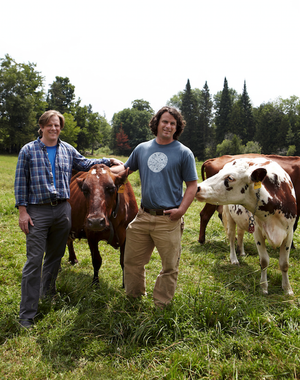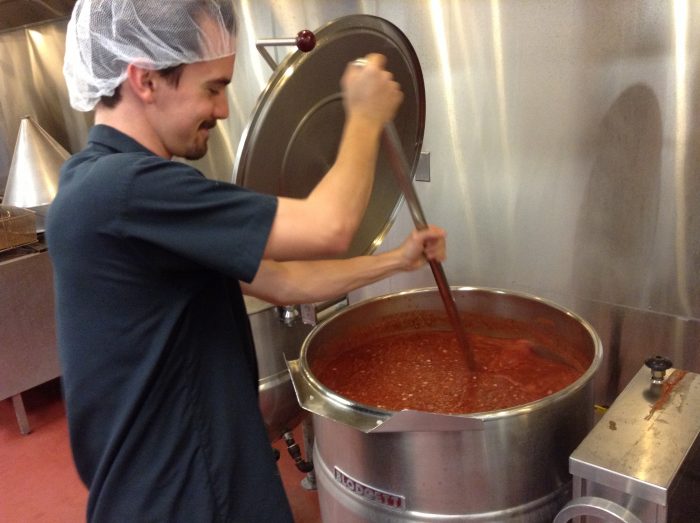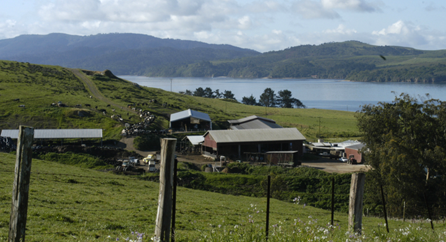Special Report: US Organic Farming Hotspots – An Opportunity for Rural Communities?
“For us, cheese has always been a vehicle to achieve this other thing,” Mateo Kehler of Jasper Hill Farm said.
“A vibrant community that’s not completely dependent on globalization. This is our response to globalization: We have the opportunity to extract wealth and redistribute it in our community in a different way.”1
Mateo and his brother Andy of Jasper Hill Farm, like all resourceful farmers, understand that making a living in rural America today requires more than just milking cows. And just like the California winemakers of an earlier generation, they set a lofty goal to challenge the best of European cheesemakers.
Can Organic Agriculture Contribute to Increasing Income for the Larger Community?
Do clusters of organic farming activity lead to higher income for farmers as well as others in their community? A recent study suggests that producing organic foods is correlated with lower poverty and increased household incomes in rural communities.
In their economic analysis, Pennsylvania State University agricultural economist, Ted Jaenicke and then-student Julia Marasteanu (who now works at the U.S. Federal Drug Administration) identified counties around the country with high levels of organic agricultural activity where a neighboring county also has high organic activity. Their analysis suggests that clusters of two contiguous hotspot counties is correlated with increased median household income by an average of $2,094 – and reduced poverty levels overall.3
This income increase in organic hotspot counties averages 4.7 percent in relative terms for all people residing in hotspot counties.
Stay in the loop with Food First!
Get our independent analysis, research, and other publications you care about to your inbox for free!
Sign up today!At a time when most workers in the U.S. are experiencing stagnant or declining income, what economic development official wouldn’t want to promote such a dramatic improvement in income?2
Vermont and California hotspots
Prime examples of organic hotspots are Orleans and Caledonia Counties in Vermont and Marin and Sonoma Counties in Northern California. In these counties on opposite sides of the country, farm-based innovations are often coupled with cooperating value-added businesses as diverse as raw and organic milk, yogurt, cheese, kale chips and other processed, bottled, and preserved food products.4
As customer interest in organic, local, and sustainable food has steadily increased in recent years, laws in many states have been updated to respond to the demand for more local and artisanal food. The 2013 California Homemade Food Act allows enterprising foodies to make and sell an extensive list of foods produced in their homes.5 Vermont allows sale of baked goods produced at home, with other products, including preserves, requiring a reasonably-priced commercial license coupled with use of a commercial kitchen for production.6
Rural Place-Based Businesses in California
At Straus Family Creamery run by Albert Straus in Marin County, California, they graze and milk cows and also buy, produce, and bottle organic milk and cream. They also make, package, and deliver butter, sour cream, ice cream, and yogurt and wholesale organic soft serve base to which others can add proprietary flavors.
In the early 1970s, development plans for the Tomales Bay region, where Straus is located, posed a threat to the long tradition of family farming in that area. Phyllis Faber and Albert’s mother, Ellen Straus, founded the Marin Agricultural Land Trust (MALT) to protect farmland and natural resources for generations to come. The land trust protects farmland through the acquisition of conservation easements, which is a voluntary transaction between the trust and the landowners.
MALT has preserved more than 44,100 acres of farmland on 68 family farms and ranches that might otherwise have been sold or developed. MALT was the first agricultural land trust in the nation. Shortly after MALT was started, Albert Straus converted the family farm to organic production and then built a creamery because there were no buyers for organic milk on the West Coast.7
Cowgirl Creamery purchases raw organic milk from Straus to make their artisan cheese. Cowgirl Creamery founders Sue Conley and Peggy Smith, who started their business in the early 90s, also operate two cheese stores including a well-traveled shop and restaurant in San Francisco’s Ferry Building. Less well-known is their original distribution company, Tomales Bay Foods, that has allowed other artisanal cheese makers and home-based food businesses in Sonoma and Marin Counties to prosper. When Cowgirl Creamery started, there were a half dozen small cheese makers in Marin and Sonoma Counties. Today, there are over two-dozen cheese making companies in the region, with Cowgirl Creamery distributing many of their products nationwide via Tomales Bay Foods.8
Just shy of their 20th anniversary, Conley and Smith of Cowgirl Creamery sold their entire operation to Swiss dairy cooperative, Emmi. In 2015, Emmi posted net sales of nearly $3.3 billion. Smith and Conley will continue to operate their business as President and Vice-President, respectively. The sale to Emmi will provide capital to build a third cheese production facility in Petaluma, plus access to expertise in expanding their line of artisan cheese. The sale will also ensure that the operation, which currently employs 95 people, continues to prosper to the benefit of residents of Marin and Sonoma Counties where their primary operations are based. Conley and Smith said they view Emmi as having a strong allegiance to dairy farmers, as well as respect for the value of organic production and sustainable agriculture.
“I don’t have a crystal ball, but I feel very secure,” says Smith. “They’re a different kind of company. We’re a different kind of company. This one fits our model much closer than anything we’ve seen.”9
Preserving Rural Life in Vermont

Photo from Jasper Hill Farm
In some cases, the value of a farm product is added on the farmstead – such as at Jasper Hill Cellars where they produce, age, and market their own cheese, and also age and market cheese for other artisan cheesemakers.10 Given the current historically-low milk prices, one might expect that Jasper Hill Farm and Cellars would be having a hard time financially.10 But that certainly is not the case. Kehler said “Visioning is a big part of our culture. It’s not looking back, it’s looking forward.” Jasper Hill sells $9 million of cheese annually. “About 30 percent of Jasper Hill’s market — or roughly $3 million a year in business — comes from the sale of raw milk cheeses,” (Mateo) Kehler said.11
How did Mateo and Andy Kehler get to where they are today with Jasper Hill? In 1998, the Kehler brothers decided to settle in the rolling hills of Northeastern Vermont where they had visited their grandparents often as young boys. When the Kehler brothers bought their first farm, one in three farmers in the area had already been forced out of farming due to low milk prices. The brothers were alarmed that more of their long-time farm neighbors would be forced to abandon dairy farming.12
Beginning with a herd of 50 Ashyre cows, they soon built a creamery and began making and selling cheese.13 In 2006, they started building a 22,000-foot, state-of-the-art facility with seven underground caves, each temperature and humidity controlled to produce a specific type of cheese. Today, they employ 50 people on the farm and in the creamery and aging caves.14 After the new barn and creamery were built in 2003, folks at the long-established Cabot Creamery, a 1,200-member farmer cooperative, asked the Kehler brothers to age a special batch of Cabot Clothbound Cheddar.15 Three years later, after aging in Jasper Hill Cellars, that first batch won the American Cheese Society Best in Show. Today, Jasper Hill ages and markets cheese for Scholten Family Farm, von Trapp Farmstead and Landaff Creamery in addition to Cabot.16
“They’re incredibly collaborative,” [Catherine] Donnelly, a food microbiologist who is a professor of nutrition and food science at the University of Vermont, said of the Kehlers. “They’re helping everybody in the industry learn, and they have a great willingness to share this incredibly technical knowledge that’s expensive to access. They’ve achieved success because they’ve been collaborative, and I think people really admire them for that.”17
In 2015, Jasper Hill set up an AgriCompact Tecnologies GmbH hay-drying system at their new Eureka Cropping Center. This system allows them to use more local hay as feed, and improves the milk quality for their two herds of cows. Jasper Hill is also purchasing non-GMO grain rations to supplement their cows’ regionally-sourced, grass-based diet; thus allowing local farmers to transition to traditional alfalfa, clover and beans.19 These changes are so new that the impact that this will have on surrounding farms cannot yet be evaluated. One might expect that some part-time grain farmers will switch to organic to sell to Jasper Hill, and perhaps some community effort will lead to either shared rental time on the new hay dryer or the purchase of a second dryer by a cooperative or nonprofit organization.
In November 2015, Jasper Hill Cellars was awarded ‘Best American Cheese’ at the World Cheese Awards in Birmingham, England. The World Cheese Awards, now in its 27th year, was hosted by an international panel of 250 judges, which evaluated over 2700 cheeses. Their Harbison won a Super Gold Award, and subsequently made it into the final round of 16 World Champions.20
Vermont Value-Added Food Businesses

Photo from Vermont Food Venture Center
When the nonprofit organization Center for an Agricultural Economy proposed to build The Vermont Food Venture Center in neighboring Caledonia County as part of their mission to regenerate a locally-based, healthy food system by providing infrastructure, Jasper Hill was in a good position to lease part of the facility to operate a creamery to produce two raw milk cheeses; Alpha Tolman and Bayley Hazen Blue. Their participation insured that the center would be viable even before the first small food business signed up to lease cooking time and storage space. Today, the range of food businesses now renting includes organic seeds, salsa, kale chips, and Shrub (a vinegar and sugar preservation process that turns fruit into a drink).18
Conclusions
Julia Marasteanu and Edward C. Jaenicke’s county-by-county analysis of the United States shows that organic agriculture might be an effective way to promote rural economic development as exemplified in the four counties featured here. Farmers who are doing well have figured out that adding value to their products can improve profitability and the general financial health of their communities. Policy makers at the local, state, and national level can use this new information to support and promote organic agriculture hotspots. This work will need to account for concerns such as urban sprawl and rural gentrification to ensure economic development truly benefits the people and their communities – but this study suggests organic hotspots hold immense opportunity for rural communities.
1 Sally Pollack. Big ideas and big award at Jasper Hill Farm Cheesery, Jan. 31, 2014. http://www.burlingtonfreepress.com/story/news/2014/01/31/big-ideas-and-big-awards-at-jasper-hill-farm-cheesery-/5057801/ Jasper Hill wins world championship of raw-milk cheese, USA Today, Nov. 18, 2014. http://www.usatoday.com/story/news/nation/2014/11/18/jasper-hill-cheese-honored/19251889/
2 Edward C. Jaenicke. Hotspots White Paper, Organic Trade Association. http://ota.com/sites/default/files/indexed_files/OTA-HotSpotsWhitePaper-OnlineVersion.pdf. Organic Hotspots one pager. Organic Trade Association. http://ota.com/sites/default/files/indexed_files/OrganicHotspots_OnePager.pdf
3 Julia Marasteanu and Edward C. Jaenicke. Economic Impact of Organic Agriculture Hotspots in the United States, April 2016. http://poseidon01.ssrn.com/delivery.php?ID=832089093027127103119101087111093031050054000027004013125083085105110109110067126110107058000012017055113127088102091077117107062040012017050009001076119020094079018029071116110120114002100071101068023076124102073118071094092112090090074082091079099&EXT=pdf.
4 The Center for an Agricultural Economy. http://www.hardwickagriculture.org/. Straus Family Creamery. http://strausfamilycreamery.com/. Cowgirl Creamery. https://www.cowgirlcreamery.com/
5 http://www.cdph.ca.gov/programs/documents/fdbcfofaqs.pdf
6 http://forrager.com/law/vermont/, https://www.uvm.edu/extension/food/safety/?Page=regulations.html accessed May 27, 2016
7 http://strausfamilycreamery.com/
8 https://www.cowgirlcreamery.com/
9 Sarah Fritsche, Cowgirl Creamery Sold to Swiss Dairy Company, SF Gate.com, May 16, 2016. http://www.sfgate.com/food/article/Cowgirl-Creamery-sold-to-Swiss-dairy-company-7508019.php
10 http://www.agweb.com/article/plunge-in-milk-prices-stresses-dairy-farmers–naa-associated-press/
11 http://www.jasperhillfarm.com/
12 Sally Pollack. Jasper Hill wins world championship of raw-milk cheese, Nov. 18, 2014. Burlington Free Press. http://www.burlingtonfreepress.com/story/life/2014/11/18/jasper-hill-wins-world-championship-raw-milk-cheese/19239959/
13 Ashyre dairy cows are preferred by many Vermont farmers and cheesemakers for their hardiness as a breed and the milk’s high fat content: http://www.raw-milk-facts.com/dairy_cow_breeds.html
14 Justine Hand, One Cheese at a Time: Jasper Hill Farm and the Rise of Vermont’s Local Food Movement. In Gardenista, October 15, 2014. http://www.gardenista.com/posts/one-cheese-at-a-time-jasper-hill-farm-and-the-rise-of-vermonts-local-food-movement
15 https://www.cabotcheese.coop/, https://en.wikipedia.org/wiki/Cabot_Creamery Accessed May 27, 2016
16 http://www.jasperhillfarm.com/cheesemakers
17 Sally Pollack. Big ideas and big award at Jasper Hill Farm Cheesery, Jan. 31, 2014. http://www.burlingtonfreepress.com/story/news/2014/01/31/big-ideas-and-big-awards-at-jasper-hill-farm-cheesery-/5057801/
18 http://www.elementshrub.com/
19 http://www.jasperhillfarm.com/eureka/
20 Zoe Brickley, Jasper Hill Farm’s ‘Harbison’ Awarded ‘Best American Cheese’. Greensboro, Vt. Globe Newswire, Nov. 27, 2015. https://globenewswire.com/news-release/2015/11/27/791068/10157372/en/Jasper-Hill-Farm-s-Harbison-Awarded-Best-American-Cheese.html


 Help Food First to continue growing an informed, transformative, and flourishing food movement.
Help Food First to continue growing an informed, transformative, and flourishing food movement.




